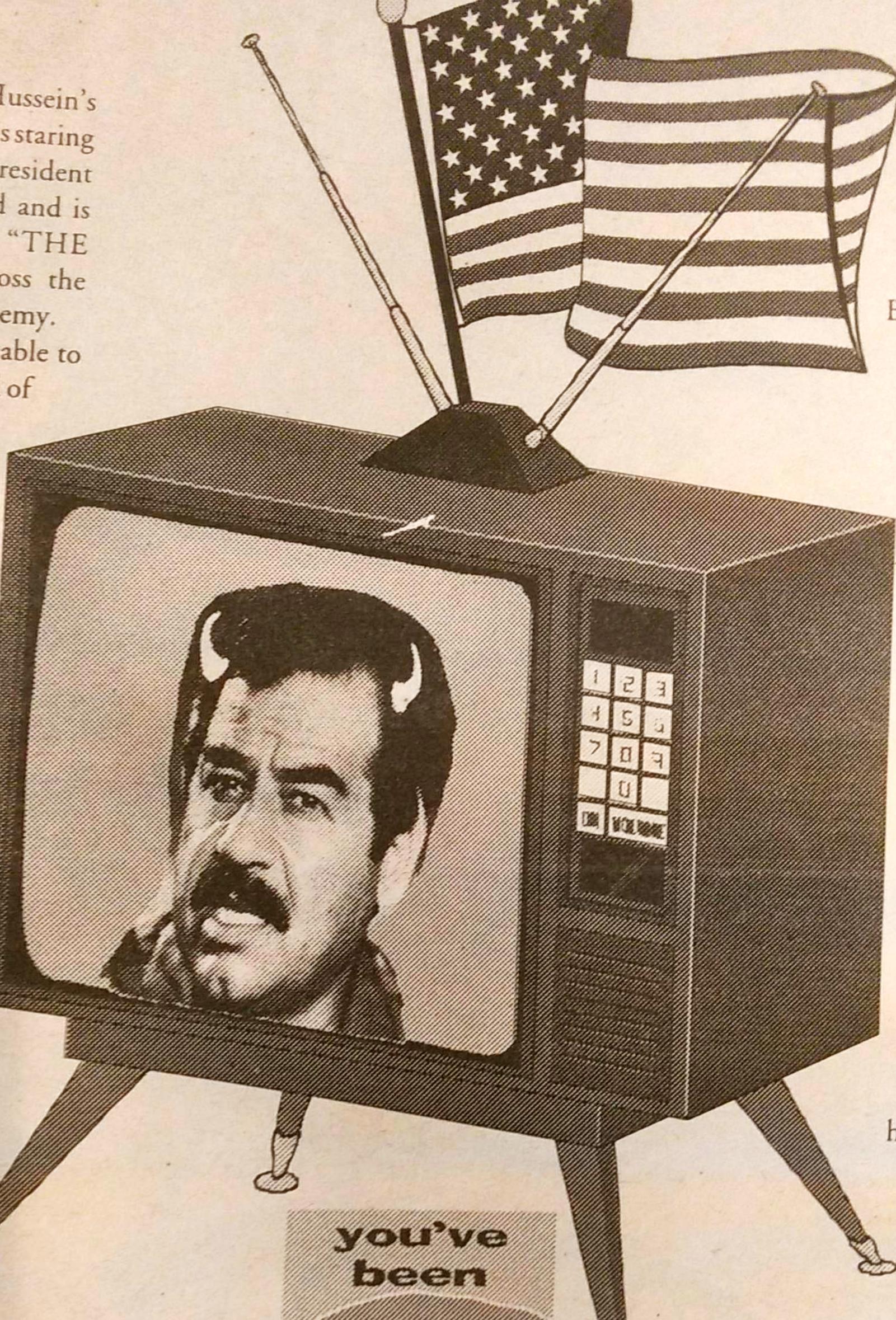By Suleman Din
Last week’s issue of Time has Saddam Hussein’s face enlarged to fit the entire cover. He’s staring down at a defiant, tuny figure of U.S. president Bill Clinton who has his back turned and is pointing at Hussein. The title “THE SHOWDOWN” is emblazoned across the cover. The U.S., we’re told, is facing a formidable enemy.
Reality begs to differ. Iraq is a crippled nation, unable to feed its own children. Iraqis are demoralized and afraid of Hussein. The U.S., on the other hand, has sent 30,000 troops to the Gulf and two aircraft carriers to patrol the Gulf’s waters. It is armed and ready for a combined tactical strike. But who is the real predator and prey here?
Journalistic principles call for objectivity in reporting but in the corporate media world “the media are huge partisan organizations,” says Wendy Winch, associate director of national programs for the Canadian Institute of International Affairs. “Everyone is compromised at some level.” We’re told who our enemies are. All it takes if a bit of peeling away to see neither the government not the media can be entirely trusted.
“Once again, Iraq takes on the world.” – Time, Nov. 24, 1997
“Iraq’s Bioweapon: Easy to Make, Easy to Hide.” – ABC, Nov. 9, 1997
If we listen to the media, it would seem Iraq is on the verge of launching an apocalyptic strike and that the world is fighting together against Iraq. However, evidence of sophisticated weapons is partial at best. The Globe and Mail called the latest U.S. victory in the Gulf “bittersweet” because the U.S. found “its closest allies had lost their stomach for military action.”
It’s depressing to hear the U.S. maintaining a righteous stance, claiming “victory for the international community.”
Winch says the media helped escalate public fear of Iraq and gave a “higher sense of moral ground for the allies.” Mark Larsen, director of finance and administration with the Canadian Institute of Strategic Studies, admits the “media is a vehicle to sell what’s going on.”
“Who wants to do an independent, objective analysis of the war? That’s not how you get rating.”
Cal Johnstone, Global News assignment editor, admits “journalists are always cognizant of what sells, what the editor wants to see and that the viewers want to see.”
He and other journalists had misgivings about what was being reported but had no other choice. Garry Dwyer-Joyce, CTV News foreign editor, says journalists were controlled by the US on what they could cover and where they went in Iraq.
“The difficulty was accepting all that tape of precision bombings from the US Army without being able to check its relevance,” Johnstone says.
“Saddam’s Love Child Lives In US. He’s Joining Army To Kill His Father.” – National Examiner, Feb. 12, 1991
The media are guilty of boosterism and crude nationalism. During the war, a New York Times editorial called Hussein “barbarous” and “an evil dreamer of death.” A cartoon in the New York Times titled “The Descent of Man” began with a figure of Clark Gable and passed through animals to a diminutive Hussein with flies buzzing around his head. The National Enquirer reported Hussein’s sexual escapades and his “passion for Little House on the Prairie.”
“It’s partly and American thing,” says Dwyer-Joyce. “They’re so patriotic they lose sight of their objectivity.”
Such hyperbole was matched by examples of reckless reporting. The New York Times’ editorial page reported that “Baghdad Betty,” an Iraqi government propaganda broadcaster, had told US troops: “GI, you should be home. While you’re away, movie stars are taking your women. Robert Redford is dating your girlfriend. Tom Selleck is kissing your lady. Bart Simpson is making love to your wife.”
The story, reported as fact, was actually a joke Johnny Carson told on the Tonight Show. Carson says his joke had been “reported as a fact on CNN, Entertainment Tonight, Garrick Utley’s Year-End Wrap-Up [on NBC] and in Time magazine.”
“The Western media is one-sided,” says Ahmed Bhaloo, president of the North American Shia Ithnaasheri Muslim Community. “They try to show how evil Hussein is or portray him to be the only person who stands up the the US. It is a confused image.”
If the US hates Saddam so much, wy do they let him stay in power, instead of trying to get rid of him like they did Manuel Noriega in Panama?
“Liberating Kuwait and protecting its oil and political interests, these are all excuses,” Bhaloo says. “The US have kept Saddam in Iraq so that they can do mischief. It serves the US’ purposes.”
The US has oil interest to protect in the Gulf. To maintain a presence in the Gulf, it needs an enemy. Saddam suits that purpose. With Kuwait, Hussein controlled 20 per cent of the world’s oil reserves. With Saudi Arabia under his belt, he would then control 45 per cent, leaving the rest of the world captive to whatever price he set. It was also a risk to the relay of US investments between $100 and $250 billion in the US and the UK alone. Iraq, however, primarily invests in the former Soviet Union and Europe.
Also, the US military was itching for a way to get rid of a lot of old weapons and flex their military muscle. The Toronto Star reported that in 1990, US arm sales went from $8 billion to $18.5 billion making America the world’s top arms supplier to the third world. Saudi Arabia was the main buyer, paying for a US defense infrastructure to ensure its protection from Iraq, making deals for billions of dollars worth of US military equipment.
Before the Gulf War, US involvement with Iraq was more rosy. The Los Angeles Times printed stories on how George Bush, as vice president in the Reagan government, personally intervened to secure controversial loans of more than $5 billion and lobbied for the export of technology to Iraq that could be used for military purposes
“Dealing on both sides of the fence is part of big power politics,” says Winch.
The American corporate media, which is the US’ greatest weapon, benefited from much of this trade. General Electric, which owns NBC, derived $9 billion of its $54.5 billion in revenues from military contracts in 1989, while NBC only provided $3.4 billion. In fact, nearly all major weapons used in the Gulf War were designed, manufactured or were supplied part and maintenance by GE. Thus, when watching media reports, the public never knew that the same source providing information had a vested interest in making sure the war continued.
“The West had build Iraq, then it destroyed Iraq, now it’s building it again,” says Bhaloo. “They all stand to benefit.”










Leave a Reply